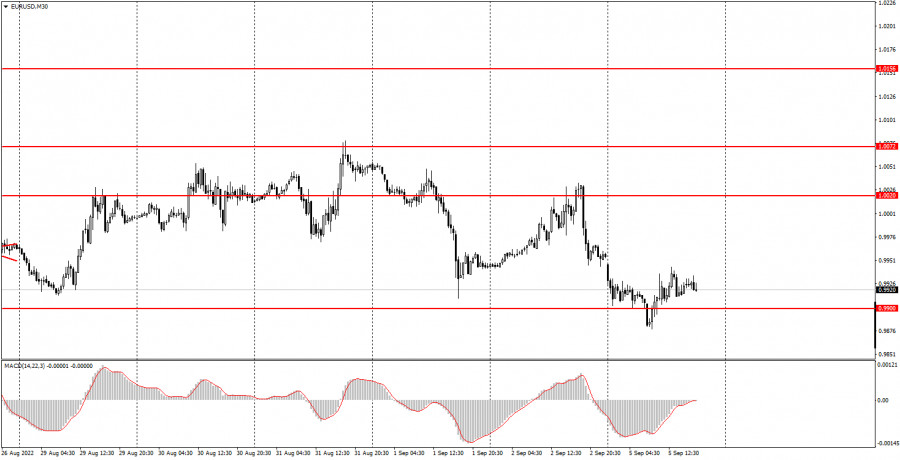

The EUR/USD currency pair on Monday showed rather weak volatility for the first time in a long time - only 65 points. There was also no trend movement during the day, as well as important macroeconomic or fundamental events. The European Union published a report on business activity in the service sector, but in the second assessment. That is, traders were already familiar with the first assessment, so the value of 49.8 points did not come as a surprise to them. A report on retail sales for July, which increased by 0.3%, which was generally in line with forecasts. We believe that these reports can be considered as neutral as possible, and therefore there was no reaction to them. And yet, the pair managed to once again update its 20-year lows. The price fell to the value of 0.9878 during the day. In addition, it broke through the lower boundary of the horizontal channel, so we can expect a resumption of the global downward trend in the near future. This week, the European Central Bank will meet, at which it is very likely that the rate will be raised. But, as we can see, at the beginning of the week this event does not interest traders at all, and they do not buy the euro "in advance".
5M chart of the EUR/USD pair
The movements also look very weak on the 5-minute timeframe on Monday. In principle, the price updated its 20-year lows at the beginning of the European trading session, after which it began to trade in a flat. Of the trading signals, we can single out only two. First, the pair settled below the 0.9900-0.9910 area, and then above it. The first sell signal turned out to be false, as the pair could not continue moving down and could not even go down 15 points. The second signal also turned out to be false, but it was possible to earn 10 points on it, since it was not canceled during the day, and there were no more sell signals or signals at all. Thus, the long position had to be closed manually in the late afternoon. The day ended with a minimal loss for novice traders.
How to trade on Tuesday:The pair begins to attempt to resume the downward trend on the 30-minute timeframe. The level of 0.9900 has already been broken, which means that the horizontal channel is still losing its relevance. Of course, the price can return to it and spend another two weeks in it. But so far we are inclined to further fall of the pair. Moreover, traders are absolutely in no hurry to work out the future ECB rate hike, which will take place this week. On the 5-minute TF on Tuesday, it is recommended to trade at the levels of 0.9900-0.9910, 0.9952, 1.0020-1.0034, 1.0072. When passing 15 points in the right direction, you should set Stop Loss to breakeven. There will be no important events or reports in the EU on Tuesday. Indexes of business activity in the services sector in two versions will be published in the US: S&P and ISM. The second index is considered more important, so we are waiting for the market reaction to it.
Basic rules of the trading system:1) The signal strength is calculated by the time it took to form the signal (bounce or overcome the level). The less time it took, the stronger the signal.
2) If two or more deals were opened near a certain level based on false signals (which did not trigger Take Profit or the nearest target level), then all subsequent signals from this level should be ignored.
3) In a flat, any pair can form a lot of false signals or not form them at all. But in any case, at the first signs of a flat, it is better to stop trading.
4) Trade deals are opened in the time period between the beginning of the European session and until the middle of the US one, when all deals must be closed manually.
5) On the 30-minute TF, using signals from the MACD indicator, you can trade only if there is good volatility and a trend, which is confirmed by a trend line or a trend channel.
6) If two levels are located too close to each other (from 5 to 15 points), then they should be considered as an area of support or resistance.
On the chart:Support and Resistance Levels are the Levels that serve as targets when buying or selling the pair. You can place Take Profit near these levels.
Red lines are the channels or trend lines that display the current trend and show in which direction it is better to trade now.
The MACD indicator (14,22,3) consists of a histogram and a signal line. When they cross, this is a signal to enter the market. It is recommended to use this indicator in combination with trend lines (channels and trend lines).
Important speeches and reports (always contained in the news calendar) can greatly influence the movement of a currency pair. Therefore, during their exit, it is recommended to trade as carefully as possible or exit the market in order to avoid a sharp price reversal against the previous movement.
Beginners on Forex should remember that not every single trade has to be profitable. The development of a clear strategy and money management are the key to success in trading over a long period of time.